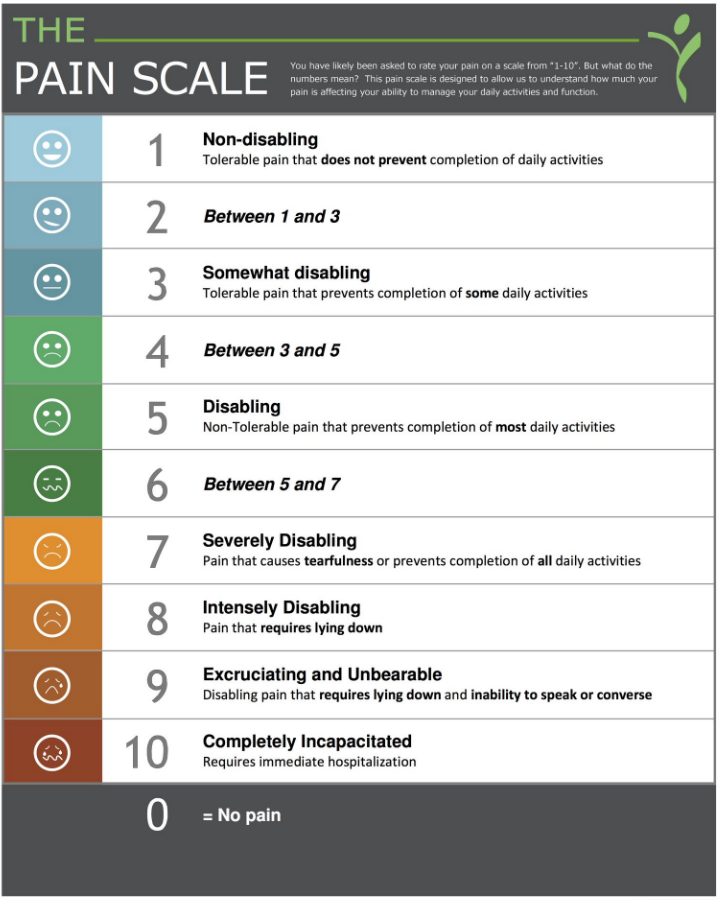Understanding Your Pain
Your care providers want to understand how much pain you have (SAMHSA)
When you meet with care providers about your pain, they will try to learn where the pain is coming from and what it is like. They will ask questions about your general health and your exercise habits. They also will ask specific questions about the pain and how it is affecting your life.
Pain usually increases and decreases across time, so it is important for your care providers to know when you have the most pain, the least pain, and about the typical pain you feel in a given day. We will ask you what makes the pain worse, and what might make it better.
Since pain treatment often does not make all pain go away, care providers also will need to know what level of pain you can live with and achieve good function. This can be different from person to person.
There are different ways for you to explain your pain to your providers. You may be asked to rate episodes of pain on a numerical scale from 0 to 10, or on a picture scale, such as a set of frowning and smiling faces. You can explain the quality of the pain, such as whether it is aching, burning, stabbing, stinging, throbbing, or a combination. You also may be asked to rate your quality of life on a scale for such factors as how you move, how you sleep, your level of stress, and your ability to perform daily activities and self-care.
Having high pain scores doesn’t mean your pain is impossible to treat, and having low scores doesn’t mean you should try to ignore your pain. At each visit your scores will be compared with your past pain scores to see if treatment is helping to reduce your pain. The following explains some examples of ways you may show your pain level and the problems it is causing you to your providers.
Here are a few examples of the many questions you may be asked to help us see the ways pain is affecting how you are doing:
- Does your pain make you stay in bed all day?
- Do you feel hopeless and helpless, non-functioning about life?
- Do you stay in bed at least half the day and have no contact with the outside world?
- Do you get out of bed but don’t get dressed? Do you stay at home all day?
- Do you work/volunteer limited hours?
- Are you able to be active at least five hours a day? eight hours a day? Have a social life outside of work?
(Based upon the American Chronic Pain Association Quality of Life Scale)https://www.theacpa.org/wp-content/uploads/2017/08/Life_Scale_3.pdf
Pain scores are just one of many tools that care providers use to understand your pain.

In summary:
Remember-Be as specific as you can about your level of pain
Sometimes your pain can feel like an 11 on a scale of 0 to 10. Chronic pain affects more than your body—it can affect your mood, your relationships, and your ability to be independent. It can also challenge your recovery from mental illness or addiction. When you are asked to rate your pain level, try to separate the feeling of pain from the suffering and disruption it is causing. Name a level that is only about your pain.
Try not to under-report or exaggerate your pain
If you are worried that your care providers will prescribe medications that could put your recovery at risk, you may be tempted to report less pain than you feel. On the other hand, if you are worried that your care providers won’t give you pain relief medications unless your pain is unbearable, you may be tempted to report more pain than you feel. This will only confuse things. If the pain medication is helping, that is good. If it is not helping, it may be discontinued altogether.
In general, your pain level is only one factor that is considered when prescribing pain medications. Be straight-forward about your pain level, and speak up about your concerns about pain medications.
Help your care providers understand how the pain affects you
Try not to answer questions about pain with one word, such as “yes,” “no,” or “fine.” Instead, give some details. Help your care providers understand what activities are important to you, and those that are hard to do now because of your pain.
